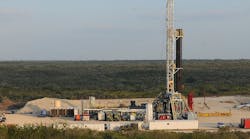- One of two boilers on Maxus Widuri storage tanker, were converted by the U.K.'s Hamworthy Combustion Engineering Ltd. to burn wellhead gas, crude oil, or diesel fuel. [17,716 bytes]
- Conversion of two boilers on Maxus Widuri crude oil storage tanker involved fitting of six dual-fuel burners. Photos courtesy of Hamworthy. [20,252 bytes]
The conversion was done by Hamworthy Combustion Engineering Ltd., Poole, U.K., which said the tariff for sale of electric power will enable Maxus to recover the cost of conversion in just a few months.
The FSO tanker is being leased from shipowner Tanker Pacific and was installed in Widuri oil field in the South China Sea off Indonesia.
Hamworthy replaced the ship's original steam turbo-alternators and engines with two new units, each with capacity to generate 12.5 MW of electric power.
Maxus Widuri typically uses 1.2 MW of steam power, rising to 3.2 MW during offloading.
The ship now has capacity to generate 23.8 MW of electric power when it is not offloading, with excess power being exported via a subsea cable to a nearby platform, which distributes power to others in the same field.
Hamworthy said boilers on a floater are normally used for steam generation to supply cargo pumps, turbo alternators, heating coils in the storage tanks, and general heating requirements. They are typically run at 20% of capacity.
On Maxus Widuri, Hamworthy converted two main 75 metric ton/hr steam boilers to run at full load continuously. They can now run off wellhead gas, stored crude oil, or diesel. Associated gas is the cheapest option.
The conversion was required to provide electrical power for downhole pumps being installed under continuing field development. Conversion took 14 months, of which the ship spent 9 months in a shipyard at Jurong, Singapore.
During conversion, the boilers were completely rebuilt, and their superheaters were replaced to cope with high furnace and exhaust temperatures associated with burning gas. Six dual-fuel burners were fitted with new ancillary equipment.
Copyright 1997 Oil & Gas Journal. All Rights Reserved.

